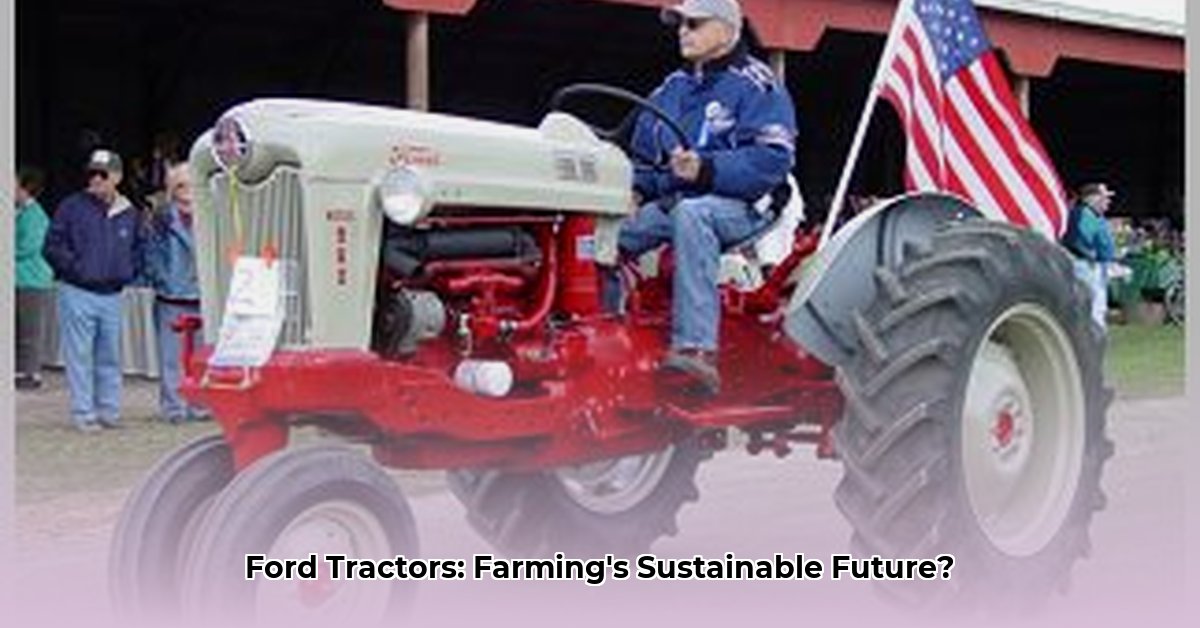
The story of Ford tractors is more than just a chronicle of agricultural machinery; it's a reflection of farming's evolution and the ongoing pursuit of sustainable practices. This narrative explores Ford's innovations, their impact on efficiency, and the complex interplay between technological advancement and environmental responsibility. For more information on restoring your Ford tractor, check out these replacement seats.
The Ford 9N: A Revolution in the Fields
Imagine a world where farming was predominantly manual labor. The arrival of the Ford 9N tractor in 1939 dramatically altered this reality. Its relatively low cost made it accessible to a wide range of farmers, and its innovative three-point hitch system revolutionized tool attachment. Tasks that once took weeks could now be completed in days. The 9N, therefore, was not just about increased speed; it symbolized a transition from human-powered agriculture to mechanized farming. This shift fundamentally changed agriculture, laying the foundation for future advancements. How did this single machine reshape the landscape of farming, and what were its immediate impacts on productivity?
Ford's Tractor Evolution: More Power, More Features, More Questions
Following the 9N's success, subsequent Ford tractor models showcased continuous advancements in power and sophistication. Larger engines allowed farmers to cultivate larger areas, while features like power steering and improved transmissions enhanced ease of use and efficiency. This progress reflects a clear trajectory – a steady increase in technological capabilities. However, this pursuit of greater power came with environmental consequences. Larger engines meant increased fuel consumption and a correspondingly larger carbon footprint. This presents a critical question: Was the increased efficiency worth the environmental cost? Striking a balance between increased productivity and environmental responsibility remains a central challenge within modern agriculture.
Ford Tractors and Sustainability: A Complex Relationship
Did Ford tractors directly promote sustainable farming practices? The answer is multifaceted. While increased efficiency undoubtedly boosted productivity, the environmental impact deserves careful consideration. The trade-off between increased output and fuel consumption—and consequently emissions—remains a key challenge in modern agriculture. It's a complex equation without easy answers, demanding a nuanced understanding that looks beyond immediate benefits towards long-term environmental consequences. Did the benefits outweigh the environmental costs?
Comparing the Giants: A Look at Key Ford Tractor Models
To illustrate Ford's technological progression, let's compare several key models:
| Model | Year Introduced | Engine Horsepower | Notable Features |
|---|---|---|---|
| Ford 9N | 1939 | 9 | Affordable, revolutionary three-point hitch |
| Ford 8N | 1947 | 12 | Increased power and improved reliability |
| Ford 2000 | 1960 | 36 | Significantly more powerful, advanced features |
| Ford 4000 | 1964 | 45 | Even more power, enhanced comfort and ergonomics |
(Note: These specifications are simplified for clarity. Actual figures may vary depending on specific configurations.)
Ford's Legacy and the Future of Sustainable Farming
Although Ford eventually exited the tractor market, its impact remains profound. Ford's innovations laid the foundation for the technologically advanced machinery used today. The current challenge, however, lies in developing farming practices that are both productive and environmentally friendly. How can we maintain or improve efficiency while minimizing negative environmental effects? A careful examination of Ford's legacy offers valuable insights into this ongoing quest.
The Path Forward: Precision Farming and Beyond
The future of sustainable agriculture hinges on precision farming techniques. These methods leverage technology to optimize resource utilization, minimizing waste while maximizing yields. Reduced tillage techniques, for instance, aim to minimize soil disturbance, leading to improved soil health and carbon sequestration. This represents a significant departure from older, more intensive farming methods. While Ford's early tractors didn't directly support these modern practices, their legacy paved the way for the technological advancements making them possible today. This evolution continues, with ongoing innovation striving to address present-day challenges and feed a growing population while preserving the planet for future generations. What are the next steps in this continuous improvement?
How to Calculate the Lifecycle Environmental Impact of Ford Tractors
Key Takeaways:
- A comprehensive lifecycle assessment (LCA) is crucial for understanding the environmental impact of a Ford tractor.
- An LCA considers all stages, from resource extraction to disposal, encompassing manufacturing, operation, and end-of-life management.
- Key factors include fuel consumption, emissions, manufacturing processes, and waste generation. Accurate data acquisition is paramount.
Understanding the true environmental cost of a Ford tractor requires a rigorous approach. This detailed assessment is pivotal in the movement towards sustainable farming practices.
Understanding Lifecycle Assessment (LCA)
A lifecycle assessment (LCA) provides a comprehensive analysis of a product's environmental impact across its entire lifespan. For a Ford tractor, this includes every stage, from the extraction of raw materials to its ultimate disposal. This detailed examination considers energy consumption during manufacturing, fuel consumption during operation, and emissions released throughout the tractor’s life cycle. Even the disposal method contributes to the overall environmental impact.
Data Gathering: The Foundation for Accurate Calculation
Accurate calculations require comprehensive data. This includes:
- Manufacturing Data: Energy usage, material consumption, and waste production during manufacturing.
- Operational Data: Fuel consumption rates, emissions data (CO2, NOx, etc.), and usage hours.
- End-of-Life Data: Information related to the tractor's disposal or recycling, including resource use and waste generation.
Calculation Methodology: A Step-by-Step Guide
- Define Scope: Clearly define the tractor model and operational lifespan.
- Inventory Analysis: Compile all data related to energy and material use, emissions, and waste.
- Impact Assessment: Employ established methodologies (e.g., IPCC guidelines) to quantify the environmental impact across multiple categories.
- Interpretation: Analyze findings and identify key environmental impact areas.
Key Environmental Impact Categories
Key categories for analysis include: greenhouse gas emissions (GHG), energy consumption, resource depletion, and waste generation. Each contributes to the overall environmental footprint.
Tools and Resources
Various tools and resources can aid in these calculations, such as LCA software packages (SimaPro, Gabi) and environmental databases (ecoinvent). These resources streamline the process and enhance accuracy. The EPA website provides further information on Life Cycle Assessment: https://www.epa.gov/life-cycle-assessment-lca